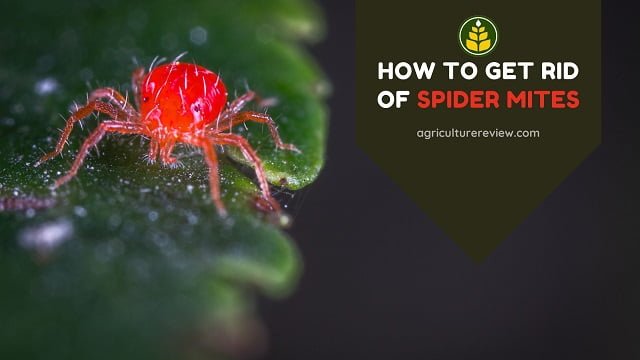Do you want to know how to get rid of spider mites? If yes, then you are on the right page to learn about spider mites control. In this article I will guide you on symptoms of spider mites pest attack, biological, organic, and inorganic control.
However, spider mites sometimes can become a very serious problem for the plants. That’s why I recommend to keep checking for symptoms regularly. In early stages of infestation, it is quite easy to control the pest.
Table of Contents
Introduction
Spider mites are tiny pests from the mites family Tetranychidae. They are less than 1mm in size and can cause damage to over 100 species of plants. They love hot and dry weather to grow and prosper. Soon after initial infestation they increase their number very rapidly.
However, you can control them through various way but the control can soon become ineffective, if repeated. Now, you have to understand this very carefully. Spider mites reproduces very fast. Hence if you will use only one type of pesticides regularly then this pest will develop resistance.
Due to this factor, the same pesticide will not be much effective. Hence, you need to keep changing the pesticides regularly. This will help to control spider mites effectively.
Symptoms
On various plant species the symptoms can be little different but there are few common symptoms. And I am going to discuss these common symptoms with you in this article.
Yellow to white spots starts appearing on the leaves. But these spots are not powdery. And will be scattered as small spots on the leaves.
Later on, you will start noticing cottony webbing on the underside of the leaves. If you will notice the leaf carefully then you will find that some of the spots will keep moving slowly. They are the mites.
These mites feeds on the leaf sap and causes destruction to the plant leaves. Soon this destruction leads to heavy damage to the plant. Photosynthesis rate decreases due to distorted leaf shape. If you will not control this pest then they can even kill your plants.
You will also love reading these,
READ MORE: WAYS TO SAVE YOUR PLANT FROM ANTS!
READ MORE: HOW TO CONTROL POWDERY MILDEW EFFECTIVELY!
How to get rid of spider mites?

To get rid of spider mites you don’t only have to know the ways to control them but you have to be smart! Because even if you will apply the pesticides then soon they will develop resistance for that chemical.
First, I will tell you about the methods to control spider mites, then I will discuss on what steps you can take to control them efficiently. Spider mites can be controlled through physical method, biological method, organic, and inorganic methods.
Physical Control
As soon as you notice the infestation, move the plant away from other plants. This will stop the spread of mites from one plant to another. But, if you are a farmer and wants to control then avoid this step for saving your plants from mites in your farmland.
Then you can wash away leaves with high pressure water stream. This will help to reduce the population of mites. But this is not very effective step, although it will be beneficial to some extent. You can also prune the infected leaves to reduce the spread.
Do not keep pruned leaves around the plants. Dispose them away from the plants.
Cold Water Treatment
Whether you are a farmer or a gardener, try this method for good results. Mites love warm and dry condition to spread. Spray on your plants with chilling cold water every morning. Only apply chilling cold water on the infested part of the plant.
Don’t worry this will not damage your plant, but it will help to control mites effectively. Do not over wet your potting soil while spraying chilling cold water on plants.
Biological Method
This method is mainly for farmers owning a large to small land. Introducing natural predators of spider mites helps to control them biologically. These predators kills and destroys spider mites.
You can introduce Lady beetles or species of predatory mites in your field. They will feed on spider mites and their population will start decreasing rapidly. This will result in healthy growth of the plant.
Organic Method
There are various organic methods that you can use to control this pest. However, do not use the same formula repeatedly. Keep changing your organic pesticides every week for this pest. The best organic pesticide for mites is neem oil.
You can get it directly from the plant store or you can make it yourself for your garden or farm. You can check out out the link below to learn to make and use neem oil spray.
READ MORE: HOW TO PREPARE AND USE NEEM OIL SPRAY
Keep spraying neem oil frequently during evenings. After one week if this spray doesn’t seem effective then you can try spraying other organic pesticide.
You can use insecticidal soap solution or any effective organic pesticides from the market. However, organic control for this pest can not be very effective always. But, many a times, they prove out to be good.
Inorganic Method
Inorganic method is the most effective method to control this pest. After trying organic methods, if the pest population keeps increasing then at last you can control the pest inorganically.
You can spray dicofol 18.5 EC @2ml in 1 litre of water during early mornings or evenings to control this pest. Spraying wettable sulphur @3 grams in one litre of water is also effective. Spray this twice in a month.
In a farm land you can also spray Chlorfenapyr 10 EC @500 ml per hectare, or Fluvalinate 25 EC @50 ml per hectare, once after every 30 days. You can purchase any of these pesticides from online stores or nearest plant store.
If the store owner doesn’t understands these prescription then you can tell him or she to give you miticide or Acaricide.
Basic Step
Controlling this pest through physical, biological, or organic method is a long time process. But, these methods have other benefits too! Like in all these methods, there is no harm to beneficial insects.
But you have to keep repeating the process frequently to save your plant. However, on the other hand inorganic control is very effective but it will also harm other insects that are not harmful for your plants.
Although I suggest you to start with physical, and organic methods. Only if they doesn’t prove to be effective then you should definitely go for inorganic method for this pest!





